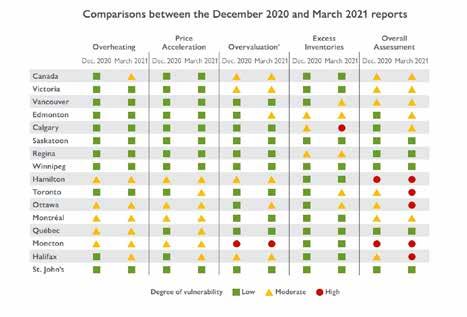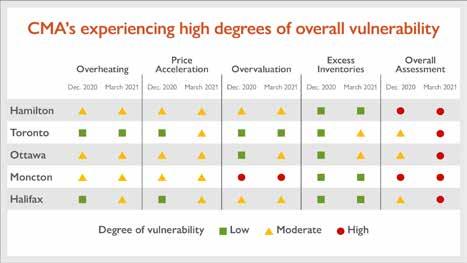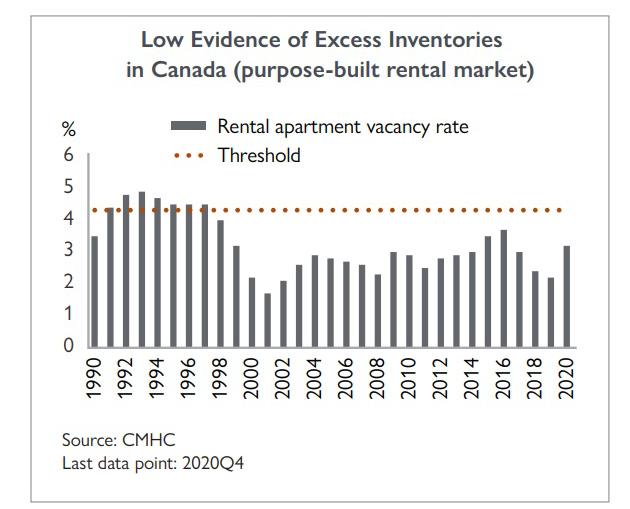
4 minute read
CANADA’S HOUSING MARKET
from FRPO April 2021
by MediaEdge
Exploring the latest data from CMHC
BY DANA SENAGAMA, PRINCIPAL MARKET ANALYST, CMHC
Sustained housing price increases still outpacing the recovery in fundamental factors, such as labour income, means Canada’s national housing market remains moderately vulnerable, with more pronounced vulnerabilities in large cities and smaller centres.
“The impacts of the ongoing pandemic continued to influence Canada’s housing markets in the fourth quarter of 2020,” said Bob Dugan, CMHC’s chief economist. “Strong housing market activity and price appreciation contributed to the emergence of new imbalances in some markets, or contributed to the worsening of existing imbalances in already vulnerable markets.”
CMHC’s current Housing Market Analysis (HMA) is based on preliminary data up to the fourth quarter of 2020, and market intelligence up to February 2021 at the national level and detailed results for 15 CMAs. Imbalances of concern include an increase in the number of CMAs displaying evidence of overheating, price acceleration and overvaluation. Housing markets across the country continued to experience elevated sales in the fourth quarter while new listings remained low.
The impacts of the ongoing pandemic continued to influence housing market conditions in Canada in the fourth quarter of 2020. Indicators of economic activity and labour market conditions showed signs of resilience and recovery in the fourth quarter, despite the renewal of stringent containment measures across many provinces aimed at mitigating the second wave of the virus.
Statistics Canada’s preliminary estimates point to an increase in real GDP of 1.9% in the fourth quarter while the estimate for 2020, as a whole, indicates a decline of 5.1%. The annual contraction in real GDP was driven by the initial impacts of the pandemic. Overall, despite strong growth in the second half of 2020, employment in Canada remained below its pre-pandemic level at the end of that year. Pronounced weakness in employment persisted in industries more impacted by pandemic health and safety measures, namely, accommodation and food services, air transportation, and tourism.
Sales remained elevated relative to new listings in several regions. There is now evidence of overheating at the national level. Sustained price growth contributed to the emergence or persistence of price acceleration and overvaluation imbalances in some markets, particularly in Eastern Canada. Among the three largest metropolitan areas, the degree of overall vulnerability of the housing market in Toronto moved to high while it remained moderate in Montréal and Vancouver.
Conditions in the rental market following the onset of the pandemic diverged from that of the homeownership market. According to CMHC data from October 2020, the purpose-built rental apartment vacancy rate in Canada increased to 3.2%, compared to 2.2% in the same period in

2019. Typical sources of rental demand had been disrupted in 2020.
Most notably, international migration into Canada was weaker and the net number of non-permanent residents entering the country had become negative. Overall, despite the national purpose-built rental apartment vacancy rate increasing in 2020, it remained below the critical threshold for excess inventories in the rental market. However, the impact of the pandemic on rental market conditions varied significantly across the country and, therefore, ratings for excess inventories differed across CMAs.
HIGHLIGHTS:
• The Toronto and Ottawa housing markets moved from moderate to high degrees of vulnerability. Price acceleration in Toronto and overvaluation in Ottawa were factors in driving the rating change. As Hamilton was already showing a high degree of vulnerability in our last HMA, the three largest Census Metropolitan Areas (CMAs) in Ontario are all now rated with a high degree of vulnerability.
• Vancouver’s housing market vulnerability remained moderate. However, Vancouver saw the quarterly pace of sales return to levels not seen since 2017, leading to significant price increases. Also, with significant downward pressure on rental demand amid the pandemic and high vacancy rates in newer rental units with high rents, Vancouver has moderate evidence of excess inventories.
• In Montréal, the degree of overall vulnerability in the housing market remained moderate. However, the quarterly pace of sales set new records.
This caused significant price appreciation in Montréal, meaning the emergence of overvaluation imbalances must be closely monitored.
• Due to increased evidence of both overheating and price acceleration, the
Halifax housing market is now rated at a high degree of vulnerability. The Moncton housing market maintains a high degree of vulnerability driven by persistent overvaluation.
• Calgary is now rated with high evidence of excess inventories, while Edmonton moved from low to moderate evidence of overvaluation. Overall, the housing markets in both of Alberta`s largest CMAs moved to a moderate degree of vulnerability.
• The Victoria housing market remains at a moderate degree of vulnerability, while
Saskatoon, Regina, Winnipeg, Quebec, and
St. John’s show an overall rating of low vulnerability.
The HMA is an analytical framework intended to detect evidence of current or emerging imbalances across housing markets in Canada. The HMA considers four key factors: overheating, price acceleration, overvaluation and excess inventories. As the number of intense and persistent signals of imbalances increases, the degree of vulnerability of the housing market becomes higher.
CMHC contributes to market stability by providing information on imbalances affecting housing markets. The HMA assesses whether the housing system places Canada’s financial stability at risk.


COVER STORY




